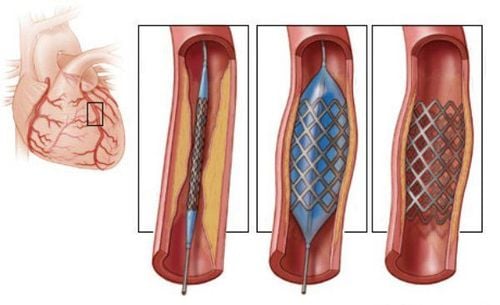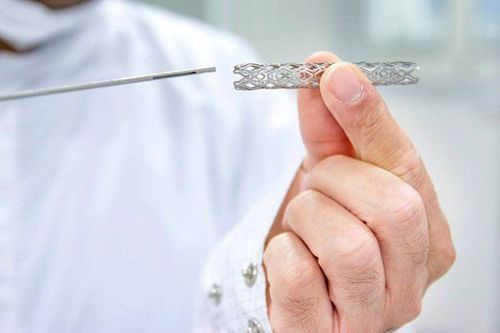This is an automatically translated article.
The article was professionally consulted by a Doctor of Cardiology - Thoracic Surgery, Vinmec Central Park International General Hospital.Angioplasty is an interventional cardiovascular technique used to dilate coronary arteries that are blocked or narrowed due to atherosclerotic plaques. Most angioplasty procedures these days incorporate a metal mesh insert, or stent, into the artery.
1. When is the patient indicated for angioplasty?
Angioplasty is used to treat a type of heart disease called atherosclerosis. Atherosclerosis is the accumulation of fatty plaques in the blood vessels of the heart. Your doctor may recommend angioplasty when other treatments don't work, like medications or lifestyle changes, aren't enough to improve your heart health, or if you've had a heart attack, angina, or other symptoms. .Angioplasty is not for all patients with atherosclerosis. If the main artery that carries blood to the left side of the heart is narrowed, if the heart muscle is weak, or if the patient has vascular disease, coronary artery bypass surgery may be a better option than a coronary artery bypass surgery. with angioplasty.
If you have diabetes and repeated blockages, your doctor may recommend coronary artery bypass graft surgery. Deciding whether to have angioplasty or bypass surgery will depend on the extent of your heart disease and your general health.
2. Advantages and disadvantages of coronary angioplasty

Kỹ thuật nong mạch vành và đặt stent là kỹ thuật ít xâm lấn hơn so với phẫu thuật bắc cầu động mạch vành
This technique is indicated when a patient has a life-threatening heart attack when angioplasty quickly restores blood flow to the heart. heart and increase the ability to save the patient's life beyond the critical. This technique relieves the symptoms of heart disease. This technique reduces the risk of future strokes. This technique improves kidney function. This technique prevents gangrene by increasing blood flow to the legs. 2.2 Cons Although angioplasty is a less invasive technique for widening blocked arteries than bypass surgery, the procedure still carries certain risks.
The most common angioplasty risks include:
Re-narrowing of the artery (restenosis). With simple angioplasty without stenting, approximately 30% of patients will experience re-narrowing of the artery. Therefore, stenting reduces this risk. Bare-metal stents reduce the risk of restenosis by about 15%, and with drug-eluting stents, the rate is only 10%. Blood clots: Blood clots can form in stents even after a coronary stent has been placed. These clots can block blood flow in the arteries, causing symptoms of a heart attack. It's important that you take aspirin, clopidogrel (Plavix), prasugrel (Effient), or another blood-reducing medication exactly as prescribed by your doctor to reduce the risk of blood clots forming in the stent. Talk to your doctor about how long it takes to take these medications. You should never stop these medications without your doctor's permission. Bleeding: You may experience bleeding in the leg or arm where the catheter was inserted. Usually in this location there is simply a bruise, but sometimes severe bleeding occurs and blood transfusion or surgery may be required. Although there is no single treatment for cardiovascular disease that works for all patients with cardiovascular disease. But the technique of angioplasty and stenting has been shown to be a highly effective, less invasive method, resulting in less pain and faster recovery. However, while angioplasty may be an ideal procedure for many people, it is not the best option for every patient, so you should always discuss treatments with your doctor.
3. Prevention after angioplasty

Giảm mức cholesterol trong máu, duy trì cân nặng ở mức phù hợp để phòng bệnh sau nong mạch vành
Quit smoking Lower your blood cholesterol levels Maintain weight Control other diseases, like diabetes and high blood pressure Get regular exercise Angiography coronary intervention and coronary stenting with a high success rate of over 95%, cerebrovascular complications: 0%, complications of acute myocardial infarction after the procedure: 0.5%, complications of bleeding after the procedure surgery: 0.8%, mortality 0.6%. To achieve this result, the technique of Angioplasty and stenting requires a high level of professional experience from the doctors and the cooperation from the patient so that the surgery can take place successfully.
Vinmec International General Hospital is one of the hospitals that not only ensures professional quality with a team of leading medical professionals, modern equipment and technology, but also stands out for its examination and consultation services. comprehensive and professional medical consultation and treatment; civilized, polite, safe and sterile medical examination and treatment space.
In April & May 2021, when there is a need for cardiovascular examination and treatment at Vinmec International General Hospital, customers will enjoy double incentives:
- Free specialist examination and 50% discount many cardiology packages such as:
+ Basic Cardiovascular Screening Package
+ Hypertension Checkup Package
+ Heart Failure Checkup Package
+ Coronary Cardiovascular Examination Package
+ Comprehensive Cardiovascular Checkup Package
- 50% off cost Fees for customers with post-examination treatment indications. The program is limited to the corresponding technique of each hospital and to customers who perform this treatment technique for the first time at Vinmec.
Please dial HOTLINE for more information or register for an appointment HERE. Download MyVinmec app to make appointments faster and to manage your bookings easily.
Article referenced source: mayoclinic.org












